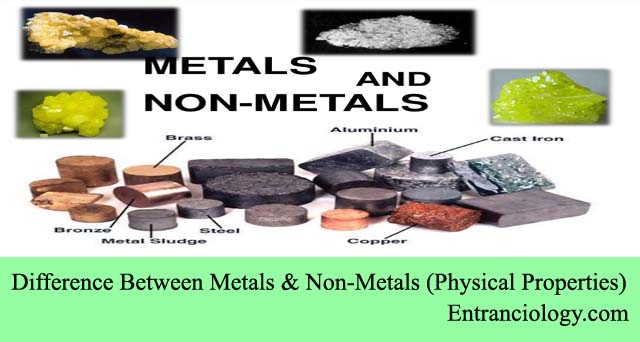
Definition of Metals : Metals are the elements that conduct heat and electricity, and are malleable and ductile. Metals are also lustrous (shiny), hard, strong, heavy and sonorous (which make strong ringing sound when struck).
Examples of Metals : Copper, Zinc, Calcium, Sodium, Gold, Silver Etc.
Definition of Non-Metals : Non-Metals are the elements that do not conduct heat and electricity, and are neither malleable nor ductile. Non-metals are brittle, and not lustrous (not shiny) i.e. they have dull appearance. They are generally soft, and not strong. Non-Metals are light substances and non-sonorous (means which do not make ringing sound when struck).
Examples of Non-Metals : Sulphur, Silicon, Oxygen, Iodine, Neon, Argon Etc.
Physical Properties of Metals
- Metals are malleable, that is, metals can be beaten into thin sheets with a hammer (without breaking). Gold and Silver metals are some of the best malleable metals.
- Metals are ductile, that is, metals can be drawn or stretched into thin wires (Gold is the most ductile metal).
- Metals are good conductors of heat. Silver metal is the best conductor of heat.
- Metals are good conductors of electricity. Silver Metal is the best conductor of electricity.
- Metals are lustrous (shiny), and can be polished i.e. they have a shining surface.
- Metals are generally hard (except Sodium and Potassium which are soft metals). Sodium and Potassium are soft metals which can be easily cut with a knife.
- Metals are strong (except Sodium and Potassium. They are not strong).
- Metals are solids at room temperature (except mercury which is a liquid metal).
- Metals have high melting points and boiling points (except Sodium and Potassium metals which have low melting and boiling points).
- Metals have high densities (Except Sodium and Potassium metals which have low densities)
- Metals are sonorous. So, metals make sound when hit with an object that’s why many metals are used for making bells, and strings (wires) of musical instruments like Violin, Sitar, Guitar etc.
- Metals usually have a silver or grey colour (except Copper and Gold)
Physical Properties of Non-Metals
- Non-metals are neither malleable nor ductile. Non-metals are brittle (break easily). Solid non-metals can neither be hammered into thin sheets nor drawn into thin wires.
- Non-Metals do not conduct heat and electricity. Carbon (in the form of Graphite) is the only non-metal which is a good conductor of electricity.
- Non-Metals are not lustrous (not shiny). They are dull i.e. they do not have a shining surface.
- Non-Metals are generally soft (except diamond which is an extremely hard non-metal). Only one non-metal Carbon (C- in the form of diamond) is very hard.
- Non-Metals are not strong. They are easily broken. For example, Graphite is the non-metal which is not strong, and it has low strength. So, when a large weight is placed on a Graphite sheet, it gets snapped (breaks).
- Non-Metals may be solid, liquid or gases at the room temperature.
- Non-Metals have comparatively low melting points and boiling points (except diamond which is a non-metal having a high melting point and boiling point). For example the melting point of Sulphur is 115 oC which is a quite low, but the melting point of Diamond is more than 3500 oC, which is very high.
- Non-Metals have low densities. So, they are light weight.
- Non-metals are non-sonorous. They don’t produce sound when hit with an object.
- Non-Metals are found in many different colours. For example, Graphite is black, Phosphorus is white or red, Chlorine is yellowish, Sulphur is yellow, Hydrogen is colourless, Oxygen is Colourless etc.


